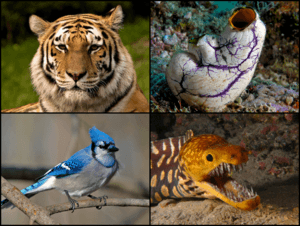Olfactores facts for kids
Quick facts for kids Olfactores |
|
|---|---|
 |
|
| Example of Olfactores. | |
| Scientific classification |
|
| Kingdom: | Animalia |
| Subkingdom: | Eumetazoa |
| Clade: | ParaHoxozoa |
| Clade: | Bilateria |
| Clade: | Nephrozoa |
| Superphylum: | Deuterostomia |
| Phylum: | Chordata |
| Clade: | Olfactores |
| Subgroups | |
|
|
Olfactores is a special group of animals. Scientists use this group to show how different living things are related. This way of grouping is called taxonomy. Olfactores is part of a larger group called Chordata. Chordata includes animals that have a notochord. A notochord is a flexible rod of tissue that forms inside a developing embryo.
In many animals, the notochord helps the spine or nervous system grow. Some animals only have a notochord and no spinal bones. Most animals in the Chordata group are also in Olfactores. Only animals like cephalochordates are in Chordata but not Olfactores.
Scientists decided to give this group a special name in 2006. They studied a lot of information about different animals. They saw that the animals in Olfactores were more closely related to each other than to cephalochordates.
Why the Name "Olfactores"?
The name olfactores comes from a Latin word. Olfactus means "sense of smell." Scientists chose this name because animals in this group have a pharynx. A pharynx is a part of their respiratory system used for breathing.
Animals like the lancelet, which are cephalochordates, do not have a respiratory system. They also do not have special organs just for smelling. This difference helped scientists group Olfactores together.
Family Tree of Life
Scientists use a "family tree" to show how different groups of animals are related. This tree is called a phylogeny. Olfactores fits into this tree as a branch of the Chordata group.
Here is how Olfactores relates to other major animal groups:
| Deuterostomia |
|
||||||||||||||||||||||||||||||
This diagram shows that Chordata splits into two main branches. One branch is Cephalochordata. The other branch is Olfactores. Olfactores then splits into Urochordata (also called Tunicata) and Vertebrata (also called Craniata). This means that tunicates and vertebrates are very close relatives within the Olfactores group.
What Animals are in Olfactores?
The Olfactores group includes some well-known animals:
- Tunicates: These are sea animals. They are often called "sea squirts." They look like sacs and live attached to rocks or other surfaces in the ocean.
- Vertebrates: This is a huge group! It includes all animals with a backbone. This means fish, amphibians, reptiles, birds, and mammals (like humans!) are all vertebrates.
There are also some ancient, extinct animals in Olfactores. These include Vetulicolia, Palaeospondylus, and Zhongxiniscus. Scientists study their fossils to learn more about the history of this group.
See also
 In Spanish: Olfactores para niños
In Spanish: Olfactores para niños

